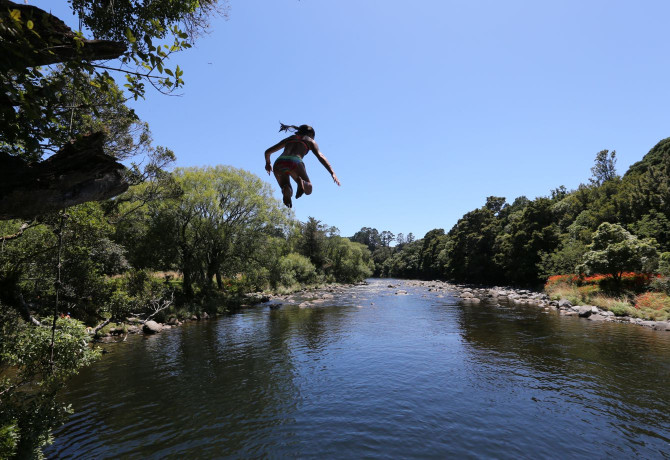Recreational water quality
Every Tuesday, from 1 November to 31 March, TRC check the water quality at 41 recreational rivers, lakes and beach sites all over Taranaki.
Water sampling results take 3 days from the time of testing to publishing on our website.
If you plan to swim today, here are some signs to look out for before jumping into the water.
- Has it rained in the last three days?
Rain washes contaminants from land into waterways, it is best not to swim for two to three days after heavy or prolonged rain – even at sites that generally have good water quality.
Stormwater can contain human and animal waste, toxic materials, debris, agriculture and urban runoff.
In town centres, rain is also the leading cause of sewage overflows.
In the case of sewage overflows, there should be no shellfish gathering for at least 28 days. - Is the water murky, cloudy or brown?
Murky water can make the water unsuitable and unsafe for swimming.
Can you see your feet in water that's knee-deep? If not, it's best to swim when the water clears. - Toxic algae
Potentially toxic algae are naturally occurring and live in a range of waterways.
During the summer months, when rainfall is low toxic algae can start to bloom and produce toxins.
These natural toxins, known as cyanotoxins, can be a threat to humans and animals when eaten, even licked, or when water containing the toxins is swallowed.
Potentially toxic algae differ from harmless bright green algae.
In rivers (and occasionally lakes), potentially toxic algae generally form brown or black mats that grow on rocks in the river bed.
In lakes, potentially toxic algae blooms are generally green in colour and can give lakes a ‘pea soup’ appearance.
When exposed, the algae may dry out and turn a light brown or white colour and may also produce a strong musty odour.
Rāhui in place
Urenui River
Te Rūnanga o Ngāti Mutunga has reviewed and updated the rāhui on the Urenui Awa (previously extending from Okoki Pā (Te Rangi Hiroa/Sir Peter Buck Memorial) to the river mouth).
The Rūnanga has resolved to reduce the rāhui placed on the Urenui awa to align with the current Te Whatu Ora public health advice. This considered decision allows for the reconnection of cultural relationships with the awa balanced with the health and safety of the entire community and maintaining the cultural significance of the rāhui.
We encourage whānau to respect the rāhui and follow the three Public Health recommendations:
- avoid swimming in the river after heavy rain, when the river water may become contaminated with run-off,
- avoid collecting kai mātaitai from the river, as shellfish can concentrate and store any bacteria and viruses present in the water, and
- stay off the mudflats below the township
Mimitangiatua (Mimi River)
Ngāti Mutunga has placed a rāhui on the awa, including the Haehanga stream. This prevents all water recreation (including swimming, shellfish gathering and fishing).
Local partners
We work closely with local District Councils and the Taranaki District Health Board to keep you safe during the swimming season. Check out their websites for more information.
Taranaki District Health Board(external link)
New Plymouth District Council(external link)
Check the latest water quality results
Find out if it's safe to swim at popular swimming spots in Taranaki using the Land, Air Water Aotearoa (LAWA) web tool below.
View sites by category: Beaches, Lakes and Rivers.
